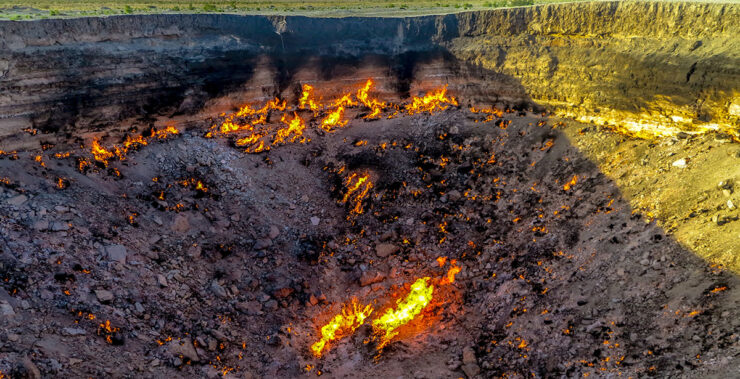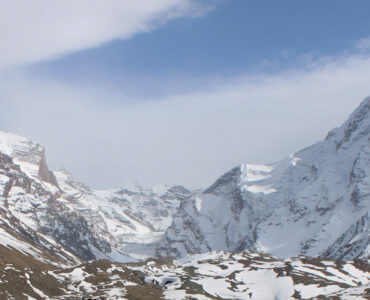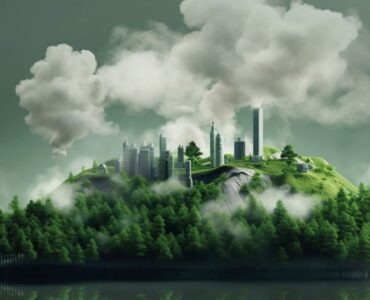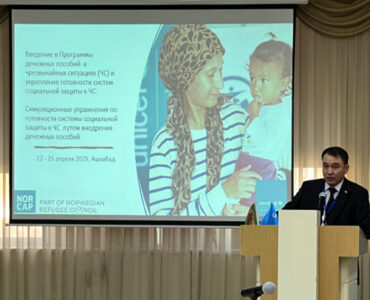Darvaza (Derweze in Turkmen) is a famous gas crater in central Turkmenistan. There was once a settlement with the same name in that area, with a population of approximately 3,000 people. The people of the settlement were forced to move in 2004 by a presidential decree and the village has been demolished.
It is infamous for the perpetually burning gas flames, which formed sometime between the early 1960s and 1970s, though the exact date remains uncertain. It is one of the most recognizable attractions of Turkmenistan, drawing significant international media attention, both as a place for tourism and as a source of greenhouse gas emissions. Despite the widespread interest, little data and information is available about the crater, the size of the emissions and its impact on public health.
The following is a compilation of publicly available data and information about the site.
Timeline
- The crater formed between early 1960s to early 1970s.
- The crater ignited in the early 1970s or in the early 1980s.
- The people of Darvaza were moved in 2004 and the village was demolished, and its constituents reshuffled and renamed by the decree by Turkmenistan Mejlis in 2016.
- Satellite images on Google Maps show no signs of sizable settlements around the crater, besides a teahouse and a railroad station nearby.
- The first recorded descent of an explorer into the crater and collection of samples of extremophiles happened in 2013.
- The government announced plans to extinguish the crater in June 2022, detailed here.
- Satellite measurements by a private company FlareIntel show emissions halved in 2023.
- Turkmenistan joins the Global Methane Pledge in December 2023.
Quantitative data
Donate to support Turkmen analysts, researchers and writers to produce factual, constructive and progressive content in their efforts to educate the public of Turkmenistan.
SUPPORT OUR WORK- 60-70 meters diameter would fit the base of the Neutrality tower or the Independence tower in Ashgabat.
- The soil discoloration reaches 500 meters to the east off of the crater.
- It is estimated to emit 3 million cubic feet of methane per day (scf/d) (FlareIntel).
- The methane is turned into CO2 with a 70% combustion efficiency, meaning that 2 million scf/d are burned and 1 million scf/d escapes into the atmosphere as CH4.
- The FlareIntel article talks about the health concern to 2,000 people living within a few kilometers but there is no settlement close to the crater anymore. FlareIntel may have based their concerns on the population estimation of the settlement before it was forced to move. Progres could not find any villages nearby on satellite images of the region.
Estimations by Progres team
- Turkmenistan consumes 765 EJ of natural gas per year (IEA) = 715 billion scf/y (EPA) = 1.96 billion scf/d so Darvaza methane represent 0.15% of the annual natural gas consumption of Turkmenistan.
- If emissions started 55 years ago, assuming a constant rate of emissions, more than 60 billion scf of methane have been emitted so far (~9% of the annual gas consumption in the country).
- Assuming natural gas price of $10/GJ, the annual revenue from 3 million scf/d would be equal to $11 million.
Scientific literature
- A study by the University of Leicester, UK estimated the potential power output if the gas stream was utilized. It could deliver 2.6% of the country power demand.
- The crater appears in various studies and scientific literature in the context of anthropogenic greenhouse gas emissions, man-made disasters.
The Darvaza gas crater is famous worldwide, often called the “Gates to Hell” for its fiery appearance. While it attracts tourists and social media attention, its greenhouse gas emissions are actually small. The country’s oil and gas industry produce much more methane pollution, which concerns climate groups and communities the most. Despite this, the government keeps highlighting its efforts to stop emissions from the crater.






